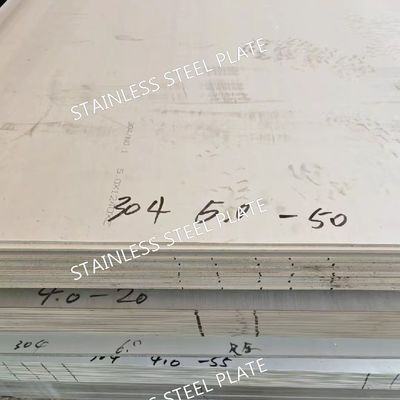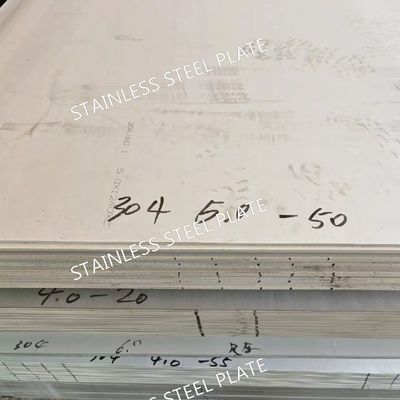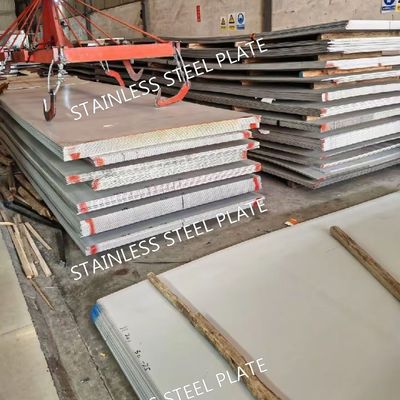-
 Raian IonescuQualidade material muito boa. nós temos cooperar mais de 10 anos. Trocam tipos dos lotes do material de aço. Toda a qualidade material boa. Eles dever para toda a qualidade material. Nós estamos aplanando para continuar a cooperar no futuro com eles
Raian IonescuQualidade material muito boa. nós temos cooperar mais de 10 anos. Trocam tipos dos lotes do material de aço. Toda a qualidade material boa. Eles dever para toda a qualidade material. Nós estamos aplanando para continuar a cooperar no futuro com eles
Hot Rolled 317L Stainless Steel Plate with Excellent Acid Resistance
| Lugar de origem | China |
|---|---|
| Marca | BAOSTEEL TISCO |
| Certificação | ISO |
| Número do modelo | 317L / S31703 |
| Quantidade de ordem mínima | 50 kgs |
| Preço | 5 - 8 USD/Kg |
| Detalhes da embalagem | Embalagem padrão para exportação |
| Tempo de entrega | 5 - 12 dias com base na quantidade |
| Termos de pagamento | L/C, T/T, Western Union |
| Habilidade da fonte | 20ton por semana |

Contacte-me para amostras grátis e vales.
whatsapp:0086 18588475571
Wechat: 0086 18588475571
Skype: sales10@aixton.com
Se você tem algum interesse, nós fornecemos a ajuda online de 24 horas.
x| Produtos | Chapa de aço inoxidável | Nota | 317L/S31703 |
|---|---|---|---|
| Grossura | 1,0-80,0 mm | Tecnologia | laminado a frio, laminado a quente, forjado |
| Largura | 1000mm 1219mm 1500mm ou costumes como o pedido | Superfície | 2B VAGABUNDOS No.1 |
| Padrão | RUÍDO DO EN DE ASTM GB JIS | Quantidade mínima | 1 tonelada |
Hot Rolled 317L Stainless Steel Plate with Excellent Acid Resistance
Stainless Steel Sheet Specifications
| Name | 317L stainless steel sheet |
| Our Grade |
200 Series: 201 202 300 Series: 301 304,304L,304H,309S,310S,314,316L,316Ti,316H,316LN,317L,321,329,347 400 Series: 409L,410,410S,416,420,430,431,436L.439,441,443,444,445,446 Super Stainless Steel: 904L,926,254SMO,654SMO,15-5PH,17-4PH,17-7PH.etc Nickel Alloy: C276, C22,G35,Alloy X,Monel 400,K500,Inconel 600,601,617,625,718,Incoloy 800,800H,800HT,825.etc |
| Technique | Hot Rolled, Cold Rolled,Forged |
| Standard | JIS, AISI, ASTM, DIN, TUV, BV, SUS, etc |
| Thickness | 0.1 – 80.0mm |
| Width range | 10mm – 2000mm |
| Length | Customized |
| Finish | 2B, BA, No.4, 8k, Brushed,Hairline,PVD Coating,Sandblasted |
| Service | Laser Cutting, Bending |
| Sample | Available |
The continuous development of modern chemical, petrochemical, and marine industries has created increasing demand for materials that can withstand both high temperatures and highly corrosive environments. Among the austenitic stainless steels available, 317L stainless steel plate has earned a strong reputation for its exceptional resistance to acid attack and chloride-induced corrosion.
This material, produced in compliance with ASTM A240 or similar international standards, offers an ideal balance of strength, durability, and superior corrosion resistance. The hot rolled 317L stainless steel plate is particularly well suited for applications that involve sulfuric acid, acetic acid, formic acid, and other aggressive chemical agents. Its mechanical stability and metallurgical consistency make it a premium choice for demanding industrial environments.
Chemical Composition
The outstanding corrosion resistance of 317L stems directly from its alloy composition. Compared with conventional 304 or 316 stainless steels, 317L has higher levels of molybdenum (Mo) and nickel (Ni), providing improved protection against pitting and crevice corrosion.
| Element | Content (%) | Function |
|---|---|---|
| Carbon (C) | ≤ 0.03 | Low carbon minimizes carbide precipitation during welding and heat treatment |
| Chromium (Cr) | 18.0 – 20.0 | Forms a passive oxide film, ensuring base corrosion resistance |
| Nickel (Ni) | 11.0 – 15.0 | Enhances toughness, ductility, and resistance to stress corrosion cracking |
| Molybdenum (Mo) | 3.0 – 4.0 | Greatly improves acid and chloride resistance |
| Manganese (Mn) | ≤ 2.0 | Stabilizes austenitic structure and improves hot workability |
| Silicon (Si) | ≤ 1.0 | Enhances oxidation resistance |
| Phosphorus (P) | ≤ 0.045 | Controlled to avoid embrittlement |
| Sulfur (S) | ≤ 0.030 | Controlled to maintain ductility |
| Iron (Fe) | Balance | Matrix metal providing strength and structural integrity |
This optimized alloy chemistry gives 317L its distinctive character—excellent corrosion resistance, good mechanical strength, and superior weldability.
Mechanical and Physical Properties
Hot rolled 317L stainless steel plate combines toughness and strength with corrosion resistance. It remains stable across a wide range of temperatures and mechanical conditions.
| Property | Typical Value | Description |
|---|---|---|
| Tensile Strength | 515 MPa (75 ksi) | Ensures durability under mechanical loads |
| Yield Strength (0.2% offset) | 205 MPa (30 ksi) | Provides sufficient elasticity and structural support |
| Elongation | 35–40% | Indicates excellent ductility for forming and welding |
| Hardness (Brinell) | ≤ 217 HB | Provides balance between strength and workability |
| Density | 7.9 g/cm³ | Typical of austenitic stainless steels |
| Modulus of Elasticity | 193 GPa | Provides high rigidity and stability |
| Thermal Expansion (20–100°C) | 16.0 × 10⁻⁶ /°C | Important for high-temperature dimensional control |
| Specific Heat | 500 J/kg·K | Reflects good thermal behavior in process environments |
These properties make hot rolled 317L plate suitable for large pressure vessels, chemical reactors, evaporators, heat exchangers, and acid storage tanks.
Key Features of Hot Rolled 317L Stainless Steel Plate
-
Exceptional Acid Resistance
The elevated molybdenum content makes 317L particularly resistant to attack from sulfuric, hydrochloric, and acetic acids. It maintains integrity even in dilute or moderately concentrated acid environments, outperforming 304L and 316L. -
Superior Pitting and Crevice Corrosion Resistance
In chloride-laden atmospheres or saline process streams, 317L demonstrates a much higher pitting resistance equivalent number (PREN) than standard stainless steels. This property is vital in chemical, pulp and paper, and marine processing facilities. -
Low Carbon for Improved Weldability
The “L” designation indicates a low carbon version, which reduces the risk of intergranular corrosion after welding or exposure to elevated temperatures. This ensures long service life for welded tanks, pressure vessels, and pipework. -
High Temperature Strength
Hot rolled 317L plate retains mechanical stability and corrosion resistance up to approximately 870°C (1600°F) in intermittent service. Its oxide film remains adherent and protective even under thermal cycling. -
Excellent Formability and Fabrication
As a fully austenitic alloy, 317L offers outstanding formability and can be easily fabricated by conventional hot and cold working methods. Hot rolling improves grain structure and homogeneity, enhancing strength and toughness.
Corrosion Resistance in Acidic Environments
One of the major advantages of hot rolled 317L plate is its outstanding performance in acidic and chloride environments.
Resistance in Specific Acids
| Acid Type | Concentration / Condition | Corrosion Behavior |
|---|---|---|
| Sulfuric Acid (H₂SO₄) | Up to 5% concentration at 120°F (49°C) | Excellent resistance |
| Phosphoric Acid (H₃PO₄) | Moderate concentration | Better than 316L |
| Acetic / Formic Acids | High concentration, up to boiling | Excellent resistance |
| Hydrochloric Acid (HCl) | Low concentration / occasional contact | Superior to 304 and 316 |
| Organic Acids | General exposure | Highly resistant due to molybdenum addition |
The superior performance of 317L arises from its robust passive film, which rapidly reforms when damaged and remains stable in the presence of halide ions.
Resistance to Chloride-Induced Attack
Chloride stress corrosion cracking (SCC) is one of the main degradation modes in stainless steels used in marine and chemical environments. Due to its high nickel and molybdenum content, 317L has a much higher SCC threshold temperature and chloride concentration limit than conventional grades.
Manufacturing and Processing Characteristics
Hot rolling is a critical step in the production of 317L plates. The process not only defines thickness and dimensional accuracy but also enhances grain refinement and surface quality.
-
Hot Rolling Process
The alloy is heated above its recrystallization temperature (typically 1100–1200°C) and then rolled to the desired thickness. This ensures uniform grain size and improved toughness. -
Heat Treatment
After hot rolling, plates are solution-annealed at 1010–1120°C followed by rapid water quenching to remove residual stresses and restore corrosion resistance. -
Surface Finishes
Available finishes include No.1 (hot rolled, annealed, and pickled), 2D, and 2B for general industrial use. A smooth, clean surface helps maintain passive layer integrity in corrosive environments. -
Machining and Forming
317L work-hardens quickly, so machining should use slow speeds and sharp tools. Cold forming is possible, but intermediate annealing may be required for deep forming operations.
Typical Dimensions and Product Forms
| Parameter | Range / Availability |
|---|---|
| Thickness | 3 mm – 100 mm (standard) |
| Width | 1000 mm – 2000 mm |
| Length | 2000 mm – 6000 mm or customized |
| Surface Finish | No.1 (hot rolled, annealed, pickled), 2B, BA, No.4 |
| Edge Condition | Mill edge / Slit edge |
| Standards | ASTM A240 / ASME SA240 / EN 10088 / JIS G4304 |
The material is typically supplied in plate form for heavy industrial and chemical processing applications.
Applications
The combination of acid resistance, strength, and weldability makes hot rolled 317L stainless steel plate suitable for a wide range of industries:
1. Chemical and Petrochemical Processing
Used in equipment such as reactors, evaporators, storage tanks, and heat exchangers handling sulfuric or phosphoric acids.
2. Pulp and Paper Industry
Applied in bleach towers, digesters, and chemical recovery systems where exposure to acidic and chloride chemicals is constant.
3. Marine and Offshore Structures
Excellent resistance to seawater and salt spray makes it suitable for offshore platforms, desalination plants, and shipboard components.
4. Power Generation and Pollution Control
Utilized in flue gas desulfurization systems, heat recovery units, and condensers where corrosive gases and condensates are present.
5. Food and Pharmaceutical Equipment
Chosen for hygiene, corrosion resistance, and cleanability in acid-cleaning environments or sterilization systems.
Comparison with Other Stainless Steel Grades
| Property / Grade | 304L | 316L | 317L |
|---|---|---|---|
| Chromium (%) | 18–20 | 16–18 | 18–20 |
| Nickel (%) | 8–12 | 10–14 | 11–15 |
| Molybdenum (%) | — | 2–3 | 3–4 |
| Pitting Resistance | Moderate | Good | Excellent |
| Acid Resistance | Fair | Good | Outstanding |
| Weldability | Excellent | Excellent | Excellent |
| Relative Cost | Low | Medium | Higher |
| Typical Application | General construction | Marine, food equipment | Chemical, acid plants |
The data show that 317L’s chemical composition upgrades make it particularly advantageous for acid and chloride-rich environments, outperforming 316L in longevity and corrosion protection.
Advantages of Hot Rolled 317L Plate
-
High Corrosion Resistance: Protects against acids, alkalis, and chlorides.
-
Weldability: Low carbon eliminates post-weld sensitization.
-
Formability: Easy to fabricate through conventional methods.
-
Durability: Long life and reduced maintenance costs.
-
Heat Resistance: Performs well in elevated temperature operations.
-
Surface Finish Options: Adaptable for industrial and architectural uses.
These advantages combine to provide an ideal material for industries prioritizing corrosion resistance and operational reliability.
Fabrication Recommendations
-
Welding:
-
Suitable methods: TIG, MIG, shielded metal arc welding, plasma arc.
-
Recommended filler: 317L or 317LMN to maintain alloy balance.
-
Post-weld cleaning with acid pickling and passivation is essential to restore the protective film.
-
-
Forming:
-
Cold forming can be done easily; annealing may be required after heavy deformation.
-
Hot forming is best performed at 1150–1260°C followed by rapid cooling.
-
-
Surface Treatment:
-
After fabrication, surfaces should be cleaned to remove any scale, contaminants, or welding residues.
-
Mechanical polishing or acid pickling ensures maximum corrosion resistance.
-
Quality Assurance and Standards
All 317L plates are manufactured according to internationally recognized standards to guarantee consistency, strength, and corrosion resistance.
-
Standard: ASTM A240 / ASME SA240
-
Grade: 317L (UNS S31703)
-
Heat Treatment: Solution annealed and water quenched
-
Testing: Chemical analysis, mechanical testing, ultrasonic inspection, and corrosion testing as per specifications
-
Certification: Mill test certificate (EN 10204 3.1 or 3.2) ensures full traceability
Maintenance and Service Life
In service, hot rolled 317L stainless steel plate requires minimal maintenance due to its self-passivating surface. For environments with severe acid or chloride exposure, regular washing with clean water to remove deposits will further extend its lifespan. With proper design and care, service life can exceed decades, offering an excellent return on investment.
Summary
The Hot Rolled 317L Stainless Steel Plate with Excellent Acid Resistance is a high-performance material engineered for environments where corrosion, heat, and acid exposure threaten structural integrity. Its enhanced molybdenum and nickel content, combined with low carbon, ensures exceptional resistance to a wide variety of chemical and marine conditions.
Key takeaways include:
-
Outstanding resistance to sulfuric, acetic, and phosphoric acids
-
Superior pitting and crevice corrosion resistance in chloride environments
-
Reliable weldability and formability
-
Long-term durability and strength under high temperature and mechanical stress
-
Compliance with ASTM A240 ensures consistent performance and quality
Whether for chemical processing plants, marine infrastructure, or acid-handling equipment, 317L stainless steel plate stands out as one of the most dependable and versatile materials available. It offers engineers and designers a reliable foundation for long-lasting performance, reduced maintenance, and maximum corrosion protection in the harshest industrial and environmental conditions.
![]()
![]()
![]()
![]()










